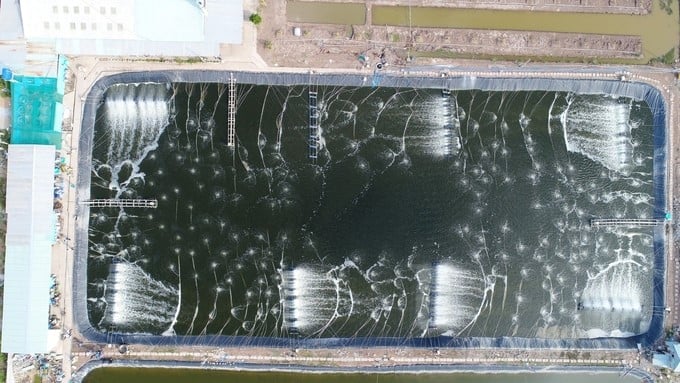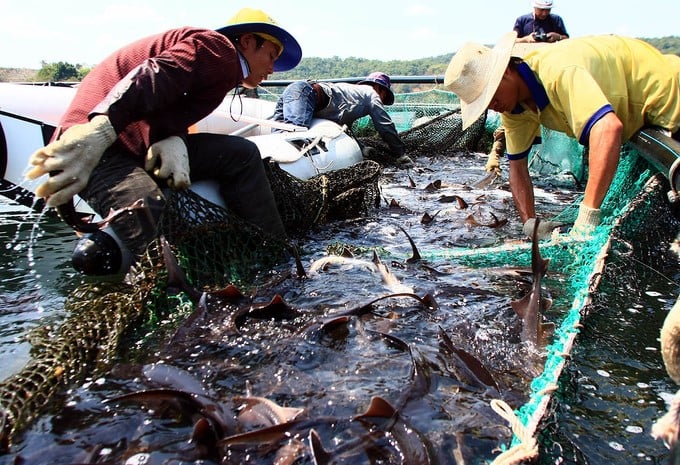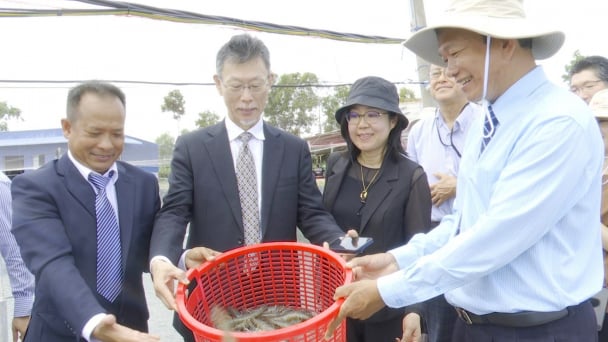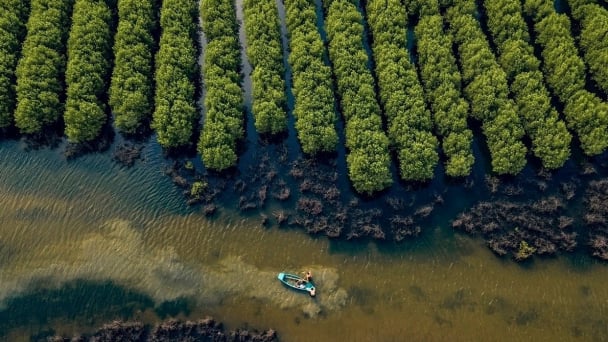June 15, 2025 | 00:21 GMT +7
June 15, 2025 | 00:21 GMT +7
Hotline: 0913.378.918
June 15, 2025 | 00:21 GMT +7
Hotline: 0913.378.918

Environmental monitoring in aquaculture is still limited, both in terms of finance, equipment, and humans. Photo: HT.
The Department of Fisheries (Ministry of Agriculture and Rural Development) has just held a conference to discuss solutions to implement the 2025 plan and remove difficulties and obstacles in implementing fishing vessel management, seafood exploitation, aquaculture, and handling administrative violations in the fisheries sector.
Mr. Vu Duyen Hai, Deputy Director of the Department of Fisheries, said that the work against illegal, unreported, and unregulated (IUU) fishing in many localities has currently seen clear changes, especially in fleet management and handling violations. Many localities have actively supported fishermen in completing procedures, documents, and digital transformation and integrating technology to trace the origin of exploited seafood.
Regarding the aquaculture sector, Mr. Ngo The Anh, Head of the Aquaculture Office (Department of Fisheries), assessed that the aquaculture sector in 2024 encountered many difficulties, especially damage after typhoon No. 3 (Yagi), but still achieved some positive results.
Specifically, the total aquaculture area in 2024 is estimated to reach 1.3 million hectares for inland farming and 9.5 million m³ of marine farming cages. The total output is estimated at nearly 5.4 million tons, an increase of about 4% compared to 2023.
Accordingly, in 2025, the aquaculture sector continues to target a total area of 1.3 million hectares, remaining stable compared to 2024. Of which, the freshwater farming area will be 380,000 hectares, the salt and brackish farming area of 920,000 hectares, and marine farming of 9.5 million m³. Aquaculture output will reach 5.96 million tons, an increase of 5% compared to 2024, of which pangasius output is 1.65 million tons and brackish water shrimp output is 1.3 million tons.
Mr. The Anh also pointed out many difficulties and challenges that the aquaculture sector has faced in 2024 and will continue to encounter in 2025. One of the issues emphasized is the environmental monitoring work.
Assessing the current developments in the aquaculture environment, Mr. The Anh commented that the environmental quality of water sources supplied for raising brackish water shrimp, pangasius, lobster, and mollusks has pollution, affecting the growth and development of farmed seafood and hiding the risk of disease occurrence.
Mr. The Anh also pointed out nine current issues that the aquaculture sector needs to prioritize immediately. The first is to be more proactive, more responsive, and more timely to be able to closely follow reality to minimize damage caused by climate change and increasing extreme weather.
The second is to focus on infrastructure. Infrastructure now is quite weak and not guaranteed, thus limiting the application of technology and processes and lacking synchronization, leading to low performance and efficiency.
Third, the quality control of input materials, including disease issues, is currently not synchronized and comprehensive. The management capacity of some localities does not meet the requirements compared to the importance of input materials in production.
Fourth, the farming technology orientation does not match the technical and management level, resulting in low efficiency. Fifth, environmental monitoring is still limited, both in terms of finance, equipment, and humans.
Sixth, the issuance of codes and certificates for brackish water shrimp farming, marine farming, and cage farming is still slow and needs more attention.
Seventh, regarding the issue of food safety, the commitment, appraisal, and certification of commitment to implementation and use of antibiotic chemicals still have many shortcomings, especially the inspection and implementation stage after commitment and certification.
Eighth, related to output, the quality of aquatic products is uneven among processors and exporters, affecting the reputation and brand of Vietnamese seafood in the international market.
Finally, the management and law enforcement of endangered and rare aquatic species and coldwater fish remain difficult. Technology for raising these objects has not yet innovated, so more attention is needed.

Coldwater fish farming has many advantages for development but still has many limitations up to now. Photo: HT.
Director of the Department of Fisheries Tran Dinh Luan said that there are a number of issues that need to be raised and sought to be resolved immediately, including the management of breeds for aquaculture; whether feed produced in factories in the plains and then transported to the mountains and other regions has any problems in quality or price or not; the story of granting farming area codes; problems in law enforcement; focusing on food safety; and special attention to the farming environment.
"The agricultural sector is restoring soil nutrients. The fisheries industry has also begun to think about restoring the farming environment. Degraded environments cannot be farmed," Director Tran Dinh Luan emphasized.
Besides, the Director of the Department of Fisheries is also concerned about diversifying farming species. "If we only rely on exporting key products such as shrimp and pangasius, it will be very pressured. We need to think broader and further, with potential farming species such as tilapia, eels, and coldwater fish," Director Tran Dinh Luan wondered.
Translated by Thu Huyen
![Turning wind and rain into action: [4] Bringing climate bulletins to remote and isolated areas](https://t.ex-cdn.com/nongnghiepmoitruong.vn/608w/files/linhnhp/2025/06/14/1152-z6704423696987_15fd32ffc26d590d204d520c9dac6786-nongnghiep-151141.jpg)
(VAN) The Vietnam Agriculture and Nature Newspaper interviewed Mr. Vu Thai Truong, Acting Head of Climate Change and Environment at UNDP Vietnam, to gain deeper insight into how climate bulletins are delivered to farmers.

(VAN) In Tien Giang, a high-tech shrimp farm has developed a distinctive energy-saving farming model that has yielded promising results.
![Turning wind and rain into action: [3] 300.000 farmers benefit from agro-climatic bulletins](https://t.ex-cdn.com/nongnghiepmoitruong.vn/608w/files/news/2025/06/12/e5a48259d6a262fc3bb3-nongnghiep-125122.jpg)
(VAN) The agro-climatic bulletin has become a valuable tool for farmers in the Mekong Delta. After more than five years of implementation, the initiative is gradually being expanded nationwide.
![Turning wind and rain into action: [2] Providing forecasts to the people](https://t.ex-cdn.com/nongnghiepmoitruong.vn/608w/files/news/2025/06/12/e5a48259d6a262fc3bb3-nongnghiep-103927.jpg)
(VAN) In addition to improving the quality of hydrometeorological forecasts, putting forecast bulletins into practical use is crucial for production and disaster prevention.

(VAN) Blue carbon is receiving attention for its rapid absorption capacity and vast potential. It represents a promising nature-based solution to respond to climate change.
/2025/06/11/3507-1-161904_583.jpg)
(VAN) Seagrass beds and coral reefs serve as 'cradles' that nurture life in the ocean depths, creating rich aquatic resources in Vietnamese waters.
![Turning wind and rain into action: [1] Forecasting for farmers](https://t.ex-cdn.com/nongnghiepmoitruong.vn/608w/files/news/2025/06/11/e5a48259d6a262fc3bb3-nongnghiep-111919.jpg)
(VAN) Weather is no longer just a matter of fate. Forecasts have now become an essential companion for farmers in every crop season.